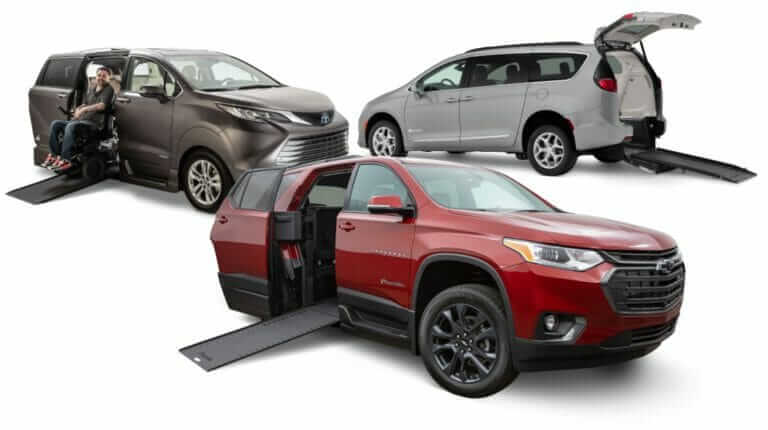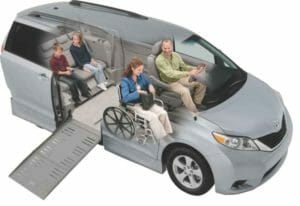Purchasing a wheelchair-accessible vehicle is a significant decision that can significantly impact mobility and independence. Therefore, to ensure the vehicle you purchase is the best choice, it’s essential to be well-informed and consider several key factors. This article will cover the top 10 most important things to consider when buying a wheelchair-accessible van or SUV.

The primary purpose of a wheelchair-accessible vehicle is to provide independence for wheelchair users. Therefore, it’s important to consider the vehicle’s ramp or lift system type and size, and weight capacity. Also equally important is the size of the ramp and door opening. You must ensure the entry and exit points are wide enough for your wheelchair. You can view various wheelchair van & SUV conversion specifications here.
Make sure there’s ample room inside the vehicle for the wheelchair user, as well as any additional passengers and cargo. Consider the height of the vehicle’s ceiling, the amount of legroom, and the space available for maneuvering a wheelchair. You can find specific vehicle specifications here.
You may require flexible seating options to accommodate various passengers, depending on your needs. Look for vehicles with removable or foldable seats and the possibility of installing a wheelchair lock-down system.
Consider the vehicle’s overall size and how it will fit in your garage, parking space, or driveway. Bigger vehicles may offer more room and better accessibility, but they can also be more challenging to park and maneuver.
Your wheelchair-accessible vehicle should have essential safety features like airbags, anti-lock brakes, and electronic stability control. Additionally, consider any specific safety equipment for wheelchair users, such as secure tie-down systems and restraint belts.
The wheelchair van conversion industry is somewhat loosely regulated, and it’s important when buying a wheelchair van to look for a dealer and manufacturer who is a member of NMEDA (National Mobility Equipment Dealers Association) and their QAP (Quality Assurance Program). An NMEDA dealer & manufacturer is regulated to ensure that any vehicle sold complies with set manufacturing and safety standards. This is not always true when buying a wheelchair van from a non-NMEDA dealer or manufacturer. Many non-members sell vehicles that haven’t been crash-tested and built using substandard materials or methods that compromise factory OEM components. Bottom line, ask questions and get to know your dealer!
Research the vehicle’s maintenance requirements and overall reliability. Some wheelchair vans may require more frequent maintenance or have a higher likelihood of needing repairs. Look for reviews and ratings from reputable sources to make an informed decision. One of our mobility consultants can help provide you this information.
A comprehensive warranty can provide peace of mind and protect your investment. Look for vehicles that offer extended warranties, and understand the terms and conditions. Additionally, consider the manufacturer’s reputation for customer service and support—even the dealership’s reputation matters. Be sure you purchase from a highly-rated mobility dealer, like Superior Van & Mobility, and that they are a member of NMEDA (National Mobility Equipment Dealers Association).
While it may not be the first thing on your mind, it’s essential to consider your wheelchair-accessible vehicle’s potential resale value. Certain makes and models may hold their value better than others, which can be beneficial when upgrading or selling.
Finally, consider your budget and the overall cost of ownership in addition to the purchase price. Account for expenses like insurance, maintenance, and fuel. Explore financing options and look for any available discounts or incentives to help you secure the best deal.
Buying a wheelchair-accessible van or SUV is a significant decision that requires careful consideration. By taking the time to research and understand your specific needs, you’ll be better equipped to make an informed choice. Keep these top 10 factors in mind as you shop, and you’ll be well on your way to finding the perfect accessible vehicle.
To learn more or start looking for that perfect vehicle, please contact one of our certified mobility consultants. They will be happy to assist you in locating the right vehicle for your needs and budget.


Richard Maxwell, is a seasoned automotive marketing executive with over two decades of experience. Starting in 1999 with his advertising agency, Maxx Design & Marketing, he has consistently delivered innovative marketing solutions. After earning his MBA, Richard shifted focus to adaptive technology, serving as Marketing Manager for Superior Van & Mobility. Today, he leverages his expertise to promote and educate others about adaptive equipment in transportation and drive change in accessible mobility.